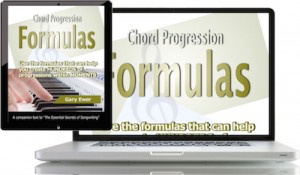When you’re writing a song, one of the best supplies of musical inspiration is your own work! As you come up with new ideas, you get excited and that excitement helps you create even more ideas. That’s normal, and the excitement you feel is what we’d otherwise call inspiration.
It’s the worst-kept secret in the songwriting world that other writers’ songs can serve as a great source of inspiration, and in fact, those other songs often wind up finding their way into your own songs.
 “Chord Progression Formulas” can give you lots of progressions to try in mere moments by using some standard easy-to-use formulas. If you like the chords-first songwriting process, you need this eBook. Get it separately, or as part of “The Essential Secrets of Songwriting 10-eBook Bundle”
“Chord Progression Formulas” can give you lots of progressions to try in mere moments by using some standard easy-to-use formulas. If you like the chords-first songwriting process, you need this eBook. Get it separately, or as part of “The Essential Secrets of Songwriting 10-eBook Bundle”
And as long as those other songs are carefully and cleverly hidden, there’s no problem at all.
In the YouTube video ‘The Story Behind The Beatles’ “Here Comes the Sun”‘, we learn that George Harrison was not only influenced by other songs — he made note of those songs on his lyric sheet, borrowing significant bits of guitar lines from a song he co-wrote with Eric Clapton a few months earlier.
All the Beatles took stylistic and performance ideas from other contemporary songwriters and groups: Bob Dylan, The Byrds, and so on. But what about actual melodic or lyrical ideas? How much borrowing can you do before it becomes a slippery slope and you’re just copying someone else’s work?
This is the kind of stuff where copyright lawyers make the big bucks. There are things you can do to someone else’s melody with no problem at all:
- Take an existing melody and reverse it, playing it starting at the end. This doesn’t always (or often) work well, but you might get melodic ideas this way.
- Take an existing melody and flip it over. In other words, if the melody starts on a C and moves upward by scale steps (C-D-E-F-G, for example), start on the C and move down by steps.
- Take an existing melody (or part of a melody), and change the tempo so significantly that it seems to bear little to no resemblance to the original tune. In doing this, you’ll probably have to change the chords underneath as well, not to mention the lyric, of course.
There are lots of things you can do with a song you love to incorporate bits into your own songs, but overall resemblance is the key issue. If, once you’re done, no one thinks of the tune you were influenced and guided by, you’re probably in the clear.
Chord progressions are almost never a problem, but keep in mind that if you’d like to use the chords from someone else’s copyrighted song, but you also borrow the rhythms, the basic feel, and some of the instrumental ideas, you’ve got a problem.
If you’ve been influenced by another song in your songwriting process, and you want to know if you’ve crossed the line, the best suggestion would be to play your song for someone else, preferably someone else in some aspect of the music world.
If they don’t hear any resemblance worth mentioning, it’s fair game to call the song your own.
It’s impossible not to be influenced by good music. It’s why we all write in the first place. And I doubt we could ever make the claim that every idea we come up with is completely detached from everything else in the music world.
So don’t worry that you’ve taken someone else’s idea and cleverly used it (completely hidden, of course) in your latest song. That’s not plagiarism. It’s simply borrowing, and it happens all the time.
 Written by Gary Ewer. Follow Gary on Twitter.
Written by Gary Ewer. Follow Gary on Twitter.
 “The Essential Secrets of Songwriting” 10- eBook bundle comes with a free copy of “Use Your Words! Developing a Lyrics-First Songwriting Process.” It’s FREE when you buy “The Essential Secrets of Songwriting 10-eBook Bundle ($37 USD) Also comes with a Study Guide
“The Essential Secrets of Songwriting” 10- eBook bundle comes with a free copy of “Use Your Words! Developing a Lyrics-First Songwriting Process.” It’s FREE when you buy “The Essential Secrets of Songwriting 10-eBook Bundle ($37 USD) Also comes with a Study Guide










